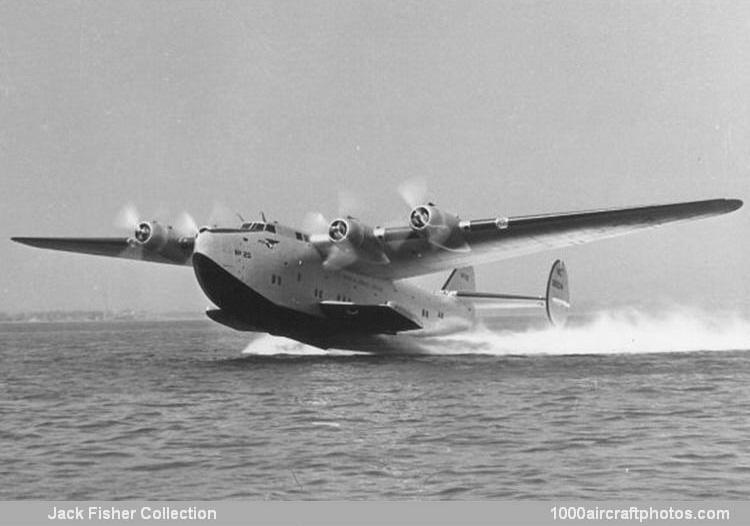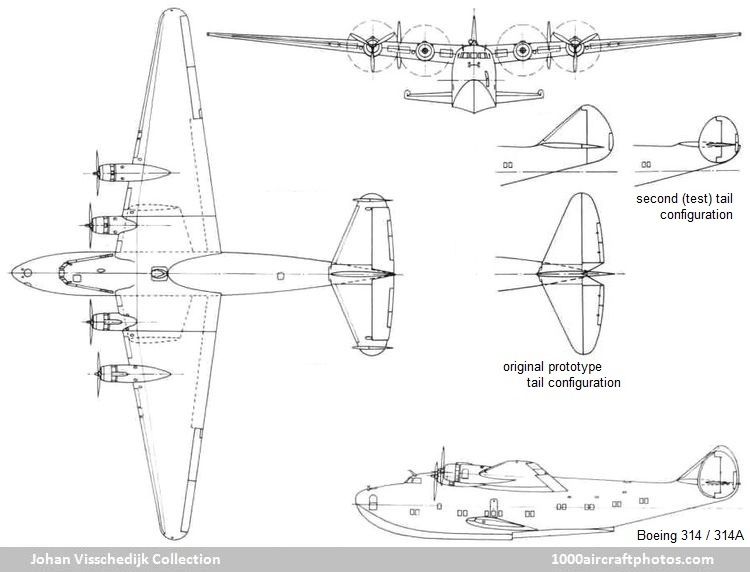03/31/2012. Remarks by Johan Visschedijk: "The Model 314 was designed to meet the requirements of Pan American Airways (PAA) for a transoceanic transport flying boat. Initial discussions with PAA had taken place in 1935, but the model number was not assigned until the spring of 1936, when the actual design was submitted. This gave the flying boat a later Boeing model number than the Model 307 Stratoliner, but was started and completed before the landplane.
A contract for six 3l4s, called 'Clippers' at the request of PAA to conform to their other flying boats, was signed on July 21, 1936, and the first one flew on June 7, 1938. After test flying the routes, NC18603 began transatlantic airmail service on May 20, 1939, and NC18605 started passenger service on June 28, 1939. Because of their size, final assembly took place on the launching ramp outside the factory. After launching into the adjacent Duwamish River, the flying boats were tied to barges and taken down the river by tugboats to the test facility that had been established among the shipyards at the south end of Elliott Bay, the seaport of Seattle.
When completed, the 314 was the largest production aircraft in regular airline service anywhere in the world, using the basic XB-15 wing and nacelles with larger engines on a conventional flying boat hull. While sponsons had been used in place of wing tip floats on flying boats ever since WW I, they were used only for the second time on an American flying boat and for the first time on a Boeing design. The crew accommodation provided a flight engineer's station and crew sleeping quarters on a separate deck from the passengers. The hull was of sufficient size to permit the passenger cabin to be divided into four separate compartments, several having slightly different floor levels because of the slope of the bottom of the hull.
As originally built, the first 314 had a single vertical tail. This gave insufficient directional control and was replaced by two, one on each end of the horizontal tail. Additional area was still needed, so a fixed vertical fin the size and shape of the original fin and rudder was added in the original
location. The 314 was powered by four 1,500 hp Wright GR-2600 Double Cyclone radial engines. While the 314 had room for a maximum of 74 passengers and up to 10 crew members, the arrangement varied according to the nature of the flight. In sleeper configuration, only 40 passengers were carried.
Six additional flying boats were built for PAA following delivery of the first six and were designated 314A because of the various improvements incorporated to improve range and performance. The first 314A flew on March 20, 1941, and all had been delivered by January 20, 1942. Improvements over the 314 included an 1,200 gal (4,542 l) increase in fuel capacity, revised interior arrangements, and engines with power increased to 1,600 hp. Following delivery of the six 314As, five of the original six were modified to incorporate the same improvements and were redesignated 314A.
After the modifications, the size of the PAA Clipper fleet was cut down by the sale of three to British Overseas Airways Corporation for wartime transatlantic service (these were operated as civil aircraft but carried full British camouflage coloring), another four were requisitioned by the USAAC Transport Command (assigned the military designation C-98). Since Transport Command was not in a position to use flying boats to the best advantage, they were turned over to the USN in 1942-1943.
The USN had requisitioned another five in 1941-1942. All USN 314As were flown by PAA crews under contract to the USN, they had no USN designation, and carried their original civil registration numbers instead of military markings. The only military aspect of their appearance was the application of standard Navy sea-grey camouflage to the top and upper side surfaces. After WW II a few aircraft returned to civil operations, by 1951 all remaining aircraft had been scrapped.
Model 314
C/n 1988, NX18601/NC18601, PAA Honolulu Clipper, first flown June 1938, converted to 314A, to USN December 17, 1941, BuNo. 48227. On March 3, 1945, two engines failed en route from Honolulu to San Francisco, aircraft made forced landing and occupants taken off by tanker SS Englewood Hills. Aircraft later sunk by gunfire.
C/n 1989, NC18602, PAA California Clipper, delivered January 1939, converted to 314A, to USN in 1942, BuNo. 99084. After WW II sold to Universal Airlines, scrapped 1951.
C/n 1990, NC18603, PAA Yankee Clipper, delivered March 1939, converted to 314A, to USN December 13, 1941, BuNo. 48224. During descending turn while attempting to land on River Tagus near Lisbon, Portugal on February 22, 1943, left wing tipcontacted water and aircraft crashed, 24 fatalities of 39 onboard.
C/n 1991, NC18604, PAA Atlantic Clipper, delivered March 1939, converted to 314A, to USN December 13, 1941, BuNo. 48225. To Universal Airlines as NC18604 August 20, 1946, salvaged for parts ca 1950.
C/n 1992, NC18605, PAA Dixie Clipper, delivered March 1939, converted to 314A, to USN in 1942, BuNo. 48226. To World Airways as NC18605 after WW II, scrapped in 1950.
C/n 1993, NC18606, PAA American Clipper, delivered June 1939, converted to 314A, to USAAF as C-98, s/n 42-88631, to USN in 1942, BuNo. 99083. To World Airways after WW II, scrapped in 1950.
Model 314A
C/n 2081, NX18607, intended for PAA, while still on assembly line PAA sold it to Airways (Atlantic) Ltd., test flown in USA as NX18607. Registered to Airways (Atlantic) Ltd. as G-AGBZ April 24, 1941, CofA July 10, 1941, named Bristol and operated by BOAC (British Overseas Airways Corporation) crew, registered to BOAC on December 3, 1941. To World Airways as NC18607 April 15, 1948, cannibalized for spares 1949, scrapped by 1951.
C/n 2082, NC18608, intended for PAA, while still on assembly line PAA sold it to Airways (Atlantic) Ltd., registered G-AGCA April 24, 1941, CofA July 19, 1941, named Berwick and operated by BOAC (British Overseas Airways Corporation) crew, registered to BOAC on December 3, 1941. To World Airways as NC18608 April 15, 1948, scrapped 1949.
C/n 2083, NC18609, PAA Pacific Clipper, delivered 1941, to USAAF as C-98, s/n 42-88632, to USN December 17, 1942, BuNo. 48228. Restored as NC18609 to Universal Airlines August 20, 1946. Damaged by storm November 1946 and subsequently salvaged for spares.
C/n 2084, NC18610, intended for PAA, while still on assembly line PAA sold it to Airways (Atlantic) Ltd., registered G-AGCB April 24, 1941, CofA July 27, 1941, named Bangor and operated by BOAC (British Overseas Airways Corporation) crew, registered to BOAC on December 3, 1941. To World Airways as NC18608 April 15, 1948, scrapped 1950.
C/n 2085, NC18611, PAA Anzac Clipper, delivered June 1941, to USAAF as C-98, s/n 42-88630, to USN June 1943, BuNo. 99082. Restored as NC18611 to Universal Airlines August 20, 1946. Damaged by fire while moored at Gibraltar February 3, 1947 and salvaged for spares in 1947.
C/n 2086, NC18612, PAA Capetown Clipper, delivered August 1941, to USAAF as C-98, s/n 42-88622, to USN June 6, 1943, BuNo. 99081. Restored as NC18612 to American International Airways, August 1946, renamed Bermuda Sky Queen. On October 14, 1947, the aircraft was sunk by gunfire from the USCG Ocean Weather Ship USS Bibb (WPG-31). The previous day the aircraft had made a precautionary landing near the USS Bibb after running low on fuel, in the following rescue operation the aircraft was damaged when it collided with the ship. The 62 passenger and seven crew were rescued, the aircraft could not be salvaged and was sunk."

